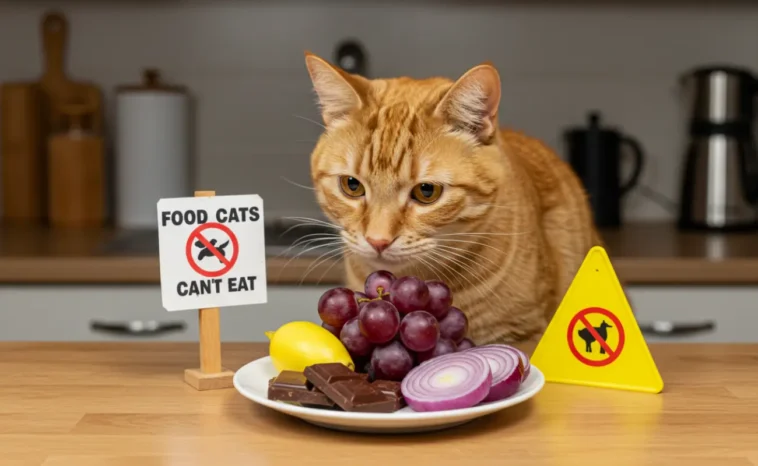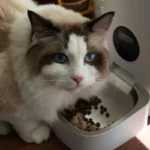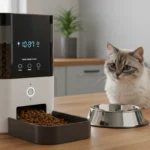Did you know that a simple snack from your plate could harm your cat more than you realize? Food Cats Can’t Eat is a topic every feline owner should explore to keep their beloved pets safe and healthy. In this article titled Food Cats Can’t Eat, we’ll discuss various human foods that pose a risk to our furry friends, along with essential tips on what food cats can eat at home. You’ll learn about the most common dangers, how to spot issues early, and how to introduce safer alternatives into your cat’s diet. By the end of this piece, you’ll have a thorough understanding of which items belong in your cat’s bowl—and which ones you should definitely avoid.
You may also want to check out jokpet.com for more insights into feline care and nutrition.
Overview
When people talk about Food Cats Can’t Eat, they usually mean the substances that are toxic or harmful to felines. Cats have a unique metabolism that is far different from humans, and certain foods that seem innocuous to us can trigger severe health problems in them. On the flip side, you may also wonder about food cats can eat—the safe, nutritious choices you can offer your feline friend at home. In this section, we’ll outline the general categories of unsafe foods before delving deeper into each type.
Why Certain Foods Are Dangerous
- Different Metabolism: Cats metabolize nutrients differently. Substances that are safe for humans can build up in their systems and cause toxicity.
- High Sensitivity: Common ingredients like onions and garlic can cause anemia in cats. Even small amounts can lead to big problems.
- Tendency to Overindulge: Cats can be picky eaters, but if they get a taste for certain human foods, they might consume too much, increasing health risks.
Examples of Foods to Avoid
- Chocolate and Caffeine: Known to be toxic to pets, can cause rapid heart rate and seizures.
- Onions and Garlic: Damage to red blood cells, leading to anemia.
- Grapes and Raisins: Potential for kidney failure.
- Raw Dough: Risk of alcohol and gas production in the digestive system.
While these categories are big red flags, there are numerous other foods that can harm your cat. In the next sections, we’ll look deeper into Food Cats Can’t Eat and provide insights into suitable, safer alternatives—food cats can eat at home to keep them happy and healthy.
Toxic and Unsafe Foods for Cats (Specific Aspect of the Topic)
In understanding Food Cats Can’t Eat, it’s helpful to categorize them based on the type of harm they can cause. Below are some common toxic groups:
1. Chocolates, Caffeine, and Theobromine
- Chocolate: A favorite treat among humans, chocolate contains theobromine, which is toxic to cats. Even a small piece could trigger vomiting, diarrhea, and increased heart rate.
- Caffeine: Present in coffee, tea, and energy drinks, caffeine can lead to restlessness, tremors, and potentially dangerous spikes in blood pressure.
Safer Alternative: Instead of offering your cat anything containing caffeine or chocolate, opt for cat-friendly treats formulated to taste sweet or savory without harmful chemicals.
2. Allium Family: Onions, Garlic, Chives, and Leeks
- Onions and Garlic: These can damage a cat’s red blood cells, causing conditions such as hemolytic anemia. The effect can be cumulative; repeated small doses may be as harmful as a single large dose.
- Chives and Leeks: Less commonly used but still part of the allium family. They pose similar risks.
Safer Alternative: If you’re preparing homemade meals, exclude onions and garlic. Instead, you can use herbs like catnip (in moderation) if your cat enjoys the scent, though typically no seasoning is best for a cat’s digestive system.
3. Grapes and Raisins
- Kidney Failure Risk: Even a small handful of grapes or raisins can lead to acute kidney problems in some cats. Symptoms include lethargy, vomiting, and decreased appetite.
Safer Alternative: Instead of grapes, choose cat-friendly fruit options like watermelon (in small, seedless chunks) or plain, cooked pumpkin. These are generally safer, though always introduce new foods gradually.
4. Raw Dough and Yeast
- Fermentation: Raw yeast dough expands in a cat’s stomach, producing alcohol and carbon dioxide, which can cause bloating and alcohol poisoning.
- Symptoms: Vomiting, disorientation, and lethargy can occur if your cat ingests raw dough.
Safer Alternative: Fully cooked bread in tiny pieces is usually okay in moderation, though not nutritionally necessary. Always skip the raw dough.
5. Xylitol and Artificial Sweeteners
- Sugar-Free Products: Often found in sugar-free gums, candies, and even peanut butter, xylitol can cause a dangerous drop in blood sugar and possible liver damage in cats.
- Symptoms: Vomiting, loss of coordination, and seizures.
Safer Alternative: If you want to give your cat a treat, look for specially made cat treats with no artificial sweeteners.
6. Dairy Products (Milk and Cheese)
- Lactose Intolerance: Many cats are lactose intolerant. Feeding them milk or cheese can result in stomach upset, diarrhea, and vomiting.
- Exceptions: Some cats tolerate dairy better than others, but it’s risky.
Safer Alternative: Check with your vet about lactose-free cat milk or small amounts of dairy alternatives designed for pets.
7. Raw or Undercooked Meat, Fish, and Eggs
- Salmonella and E. coli: Raw meats and eggs may contain bacteria that can be harmful.
- Enzyme Imbalances: Raw fish can contain an enzyme that destroys thiamine (Vitamin B1), essential for neurological function.
Safer Alternative: Cooked lean meats like chicken or turkey (without seasoning) can be a protein-rich treat for your cat.
Common Questions About Food Cats Can’t Eat
People often have a myriad of questions when it comes to what they should or shouldn’t feed their feline companions. Here are some of the most common ones:
1. Can Cats Eat Small Amounts of These Foods?
Many assume that a tiny portion won’t hurt. But for some foods like chocolate, garlic, or onion, even small quantities can accumulate and become toxic. Always err on the side of caution.
2. Is All Human Food Off-Limits?
Not necessarily. Plenty of food cats can eat at home is also on our dinner table. Safe examples include plain, cooked chicken or fish, small amounts of rice, and certain vegetables. Just ensure you serve them without seasoning or sauces.
3. What Should I Do If My Cat Accidentally Eats Something Toxic?
Contact your veterinarian immediately. If possible, have information about what was ingested, how much, and when. Prompt action can sometimes be lifesaving.
4. Are Cat-Specific Treats Always Safe?
Generally, yes. Commercial cat treats are formulated to be safe, but always check labels for artificial sweeteners or excessive salt. Some cheaper brands may still include fillers your cat doesn’t need.
5. Can Kittens Eat the Same Foods as Adult Cats?
Kittens have more delicate digestive systems and different nutritional needs. While the same toxic foods apply (kittens should never eat onions, garlic, chocolate, etc.), it’s especially important to ensure they get adequate protein, fats, and nutrients formulated for growth.
Tips for Keeping Your Cat’s Diet Safe (Topic-Related Actions or Advice)
Now that we’ve established the types of Food Cats Can’t Eat, it’s equally important to keep in mind some practical tips to ensure their daily diet remains safe and nutritious.
- Consult a Veterinarian: Before making any changes to your cat’s diet, or introducing new foods, seek professional advice.
- Read Labels: If you’re offering your cat packaged foods or treats, glance at the ingredients list. Watch out for items like onion powder, garlic salt, or xylitol.
- Use a Routine Feeding Schedule: Having set mealtimes and measuring portions can help monitor your cat’s intake, making it easier to notice if they’ve eaten something unusual.
- Safe Storage: Keep toxic foods out of reach. Cats are curious and may jump onto counters or rummage through the trash.
- Observe Changes in Behavior: If your cat shows any sign of distress, such as vomiting, lethargy, or unusual hiding, consider whether they might have ingested something harmful.
- Know Emergency Contacts: Keep your veterinarian’s phone number and an emergency clinic contact readily available.
Challenges and Solutions Related to Cat Diet
Pet owners often face challenges when trying to enforce a safe diet plan for their cat. Below are some common issues and potential solutions:
1. Picky Eaters
- Challenge: Some cats refuse unfamiliar foods, making it difficult to introduce balanced meals.
- Solution: Gradually mix the new, safe food with their old diet, increasing the proportion over time. If you’re introducing safe “people foods,” like cooked chicken, you can blend small shredded pieces with their regular cat food.
2. Inconsistent Feeding Routines
- Challenge: A busy lifestyle can lead to irregular feeding times or hastily leaving out scraps. This inconsistency might prompt cats to scavenge.
- Solution: Use timed feeders or schedule daily alarms. Consistency helps cats adapt to routine and reduces the chances of them seeking out forbidden snacks.
3. Inadvertent Human Scraps
- Challenge: Guests or children might feed the cat table scraps out of kindness. This can be dangerous if it includes Food Cats Can’t Eat.
- Solution: Educate everyone in the household about safe and unsafe foods. Keep a simple, easy-to-read list on the refrigerator or another visible spot.
4. Budget Constraints
- Challenge: Quality cat food can be expensive, and sometimes pet owners might consider cheaper, low-quality alternatives or share more household foods.
- Solution: Compare brands, look for sales, and consider the long-term veterinary costs of poor nutrition. Often, paying a bit more upfront for safe, high-quality cat food saves money in the long run.
Benefits of Safe, Home-Prepared Cat Foods
While we’ve discussed Food Cats Can’t Eat, it’s just as crucial to emphasize the positives of offering food cats can eat at home. Here’s why safe, homemade meals or carefully chosen store-bought options can be beneficial:
-
Customized Nutrition
- When you prepare your cat’s meals, you can tailor them to specific dietary needs (e.g., weight management, sensitive stomachs, etc.).
-
Better Control Over Ingredients
- Store-bought treats often have additives or fillers. Home cooking ensures you know exactly what goes into each meal.
-
Freshness and Quality
- By selecting high-quality meats and vegetables, you reduce the risk of contamination or expired products.
-
Improved Cat-Owner Bond
- Preparing food for your cat can be a bonding experience. Just be sure it’s done safely and with the right balance of nutrients.
-
Reduced Risk of Allergies and Sensitivities
- Cats with allergies may react better to single-ingredient homemade meals where the source of protein is clearly identified.
Expert Opinions or Research on Food Cats Can’t Eat
Veterinarians and animal nutritionists agree that a cat’s diet should be high in animal-based proteins and low in carbohydrates. According to Dr. Samantha Westbrook, a fictitious but representative veterinarian with 15 years of experience in feline nutrition, “Many health problems in cats arise from improper feeding habits. Pet owners tend to assume cats are ‘small humans’ and can handle table scraps—but this approach often leads to deficiencies or toxic reactions.”
Furthermore, research published in the Journal of Feline Nutritional Science (fictitious journal name for illustration purposes) suggests that nearly 30% of cat poisoning cases come from accidental ingestion of human foods. The same research emphasizes reading labels carefully—on both human and pet products—to ensure no harmful ingredients like onion powder or xylitol sneak in.
In line with professional advice, a safe cat diet usually comprises:
- High-quality commercial cat food
- Occasional vet-approved treats
- Fresh water (always available)
- Limited (if any) human foods, ensuring none fall under Food Cats Can’t Eat
Frequently Asked Questions (FAQ)
1. Can I Give My Cat a Small Taste of Chocolate Ice Cream?
Although the portion might seem small, the combination of chocolate and dairy is risky. The chocolate contains theobromine, and the dairy can upset your cat’s stomach. It’s best to avoid it altogether.
2. Are Cooked Bones Safe for Cats?
Cooked bones can splinter easily and pose a serious choking hazard, as well as cause internal damage. Never feed your cat cooked bones. If you want to incorporate bones, consult your vet about raw bones designed specifically for cats (and even then, it’s a delicate area needing expert guidance).
3. My Cat Loves Tuna—Is It Safe?
Small amounts of plain, cooked, or canned tuna (in water) occasionally are generally okay. However, too much tuna can lead to nutritional imbalances or mercury buildup. Moderation is key.
4. Can I Use Seasonings When I Cook for My Cat?
Cats don’t need seasonings, and many common seasonings like onion, garlic, or salt can be harmful. It’s best to keep their food plain, focusing on high-quality protein sources.
5. How Do I Transition My Cat to a New, Safer Diet?
Gradually mix the new food with the current one over a period of 7–10 days, slowly increasing the ratio of new food. Watch for signs of digestive upset and always consult your veterinarian if you notice anything concerning.
Conclusion & Call-to-Action
Understanding Food Cats Can’t Eat is an essential part of being a responsible cat owner. By steering clear of toxic substances like chocolate, caffeine, onions, and grapes—and instead focusing on food cats can eat in a balanced, nutritious manner—you significantly reduce the risks of accidental poisoning and nutritional deficiencies.
Safe feeding practices involve reading labels, consulting experts, and sharing knowledge with anyone in your household who might offer treats to your furry companion. By following the guidelines in this article, you’ll create a safer environment for your cat and ensure they live a longer, healthier life.
Call-to-Action: Are there other foods you’re curious about? Have you discovered any creative, cat-friendly recipes? Feel free to share your questions or experiences in the comments below. If you found this article helpful, please share it with fellow cat lovers and help us spread the word about the dangers of Food Cats Can’t Eat and the joys of food cats can eat at home.





